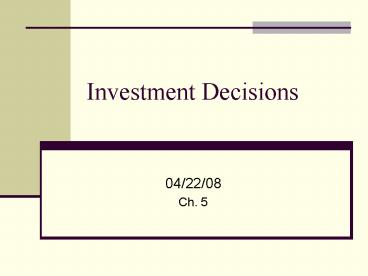Investment Decisions
1 / 13
Title:
Investment Decisions
Description:
Smart People. Innovative People. Risk Takers. Luck. Others? Do all good projects work out? ... 11 (Mutually Exclusive) Also draw the NPV profile of the two projects. ... –
Number of Views:30
Avg rating:3.0/5.0
Title: Investment Decisions
1
Investment Decisions
- 04/22/08
- Ch. 5
2
Pick Industries and Companies
- Each Group Picks Industry
- First and Second Choice
- Industries unique to a group
- Groups then pick companies
- Must trade on major exchange
- Should be US company
- Exception to US company, ADRs
- Substitutes after initial selection
- One week
3
Investment Decision
- We will examine three items in this chapter
- Incremental Cash Flow
- Decision Models
- Where good projects come from
- Incremental Cash Flow...the basis of the project
- Decision Models Discounted Cash Flow
- Picking good projects luck or talent?
4
Incremental Cash Flow
- It is only the net new dollars of a project that
are important - Sunk Costs do count in decision
- Not in the cash flow
- Could provide valuable information on cash flow
- Example, market study before product launch
- Erosion Costs
- Story of pudding pops
- When are erosion costs not erosion costs?
- Allocated Costs
- Only the additional costs should be considered
- Use accounting income format with adjustments for
the Incremental Cash Flow
5
Incremental Cash Flow
- Three main parts
- 1. Invested Capital
- 2. Operating Cash Flow
- we think of these as the income stream from the
project over the life of the project - 3. Working capital
- we think of these costs as the support of the
project, for example, inventory
6
What is the appropriate decision rule?
- Objective vs. Subjective
- Like to quantify all the important issues and
data - Like to use experience
- Solution is consistent with firm value
maximization - Works in a variety of settings
7
Some Choices that fail
- Accounting based decisions, Return on Capital
- Earnings are not cash
- Possible to manipulate the earnings
- Economic Value Added
- Again relies on accounting information to find
the Return on Equity - Is consistent with increasing firm value
8
Net Present Value
- The preferred discount model as it includes all
future cash flow discounted back to present at
the appropriate risk-related rate - NPV profile provides the NPV at various discount
rates - Is sensitive to the incremental cash flow
estimates - NPV formula
9
Internal Rate of Return, IRR
- Alternative to NPV
- Finds the discount rate at the point where the
NPV is zero then compares to hurdle rate - Has some potential problems
- Multiple IRRs
- Assumes all intermediate cash flow is reinvested
at the IRR rate - Can lead to some wrong choices when comparing
projects
10
Modified Internal Rate of Return
- Changes the reinvestment assumption of IRR from
the IRR rate to the hurdle rate - Takes all positive cash flow to the end of
project at the hurdle rate - Finds the future value of the positive cash flow
at end of project - Finds the discount rate that equates the FV of
the benefits with the PV of the costs - Is this better than IRR?
11
Where do good projects come from?
- First and foremostgood ideas
- Good ideas
- Smart People
- Innovative People
- Risk Takers
- Luck
- Others?
- Do all good projects work out?
12
How to exploit good projects
- Economies of Scale (large volume)
- Cost Advantages (overseas labor access)
- Capital Requirements (Off shore oil platforms)
- Product Differentiation (reputation or recognized
products, Coca-Cola) - Access to Distribution Channels (Microbrews)
- Legal and Government Barriers (patents and
licensing requirements)
13
Problems from Chapter 5
- 9 (Estimate NPV and IRR)
- 10 (Estimate MIRR)
- 11 (Mutually Exclusive) Also draw the NPV
profile of the two projects. What does this tell
you? - 12 (IRR puzzle)
- 16 (NPV and IRR)
- 17 (Changing discount rates)
- 19 (NPV and IRR)































